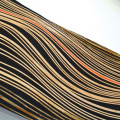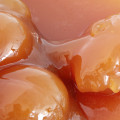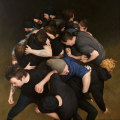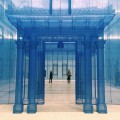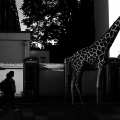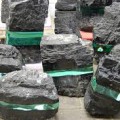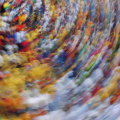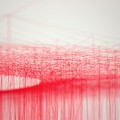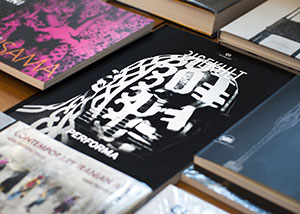Kevin Francis Gray (born 1972) is an Irish artist living and working in Pietrasanta, Italy.
Gray was born in Armagh, Northern Ireland. He studied t the National College Of Art and Design, Dublin (1995), the School of Art Institute, Chicago (1996), and he completed his MA in Fine Art at Goldsmiths, London (1999).
Gray is a figurative sculptor, who works predominantly with bronze and marble. His work has been shown in London, São Paulo, New York, Berlin, and Rome. He is currently represented by Pace Gallery, London.
Kevin Francis Gray‘s work is at once elegant and harrowing. The London-based sculptor spent his formative years in Northern Ireland surrounded by the violence between Catholic separatists and Protestant loyalists which claimed over 3,000 lives before ending in 1998. Gray, who opened an exhibition this week at Pace London, combines neoclassical sculpture and disaffected youth under a thin veil of darkness—apparently instilled in him while growing up in South Armaugh, Northern Ireland. There, in lieu of playtime, neighborhood children hurled homemade petrol bombs at the police.
According to Pace, Gray “has generated bodies of work which address the complex relationship between abstraction and figuration.” And in doing so, this artist—who recently exhibited at the Frieze art fair in London—leaves a body of work defying ideal classification, encouraging patrons to view it on their own terms.
Gray was kind enough to speak with us about his work, which has been included in exhibitions at the Royal Academy in London, Museum of Contemporary Art of the Val-de-Marne in Paris, and Art Space in New York City.
Beautiful Savage: How did you become interested in sculpture?
Kevin Francis Gray: At School, I bounced around from painting to video to sculpture. Sculpture has always been in my mind; I love envisioning a three-dimensional subject when I look at work. Painting to me felt a little more limited.
Your sculpture is haunting. But, when you’re actually making it, is your technique reductive? Additive? How do you actually come to the finished forms?
KFG: That really depends on the material. For the pieces I make in marble, I take away the stone to discover the piece underneath. Bronze is opposite because it is additive.
You grew up in Northern Ireland during a war. Did you realize at the time that this was a bit remarkable?
KFG: It was definitely rich and textural, and yet also very, very complicated. You must understand: when you’re living in a country where there’s a war happening, you never project outward. You’re only projecting inward, so you almost don’t notice the things that aren’t in your immediate environment. As you get older, you look back and reflect. It definitely does affect my work though.
How does this affect your aesthetic?
KFG: It really has, but it’s umpacted it subconsciously. There is a certain darkness underneath, particularly with the Twelve Chambers piece. I thnk it’s taken me years to understand that I have a visual core aesthetic. And what I’ve come to is that what’s on the surface isn’t the point. It’s what lies beneath. That’s what really fascinates me about my interactions with pieces. For the maquette I’m working on right now, I’m really lifting the veil. There’s something almost alone about it.
Like a dichotomy?
KFG: You got it! That’s exactly it. What you’ll be able to do is walk into the sculpture. This piece for me is the idea.
What made you decide to “uncover” your subjects?
KFG: I wanted to go a little deeper with my subjects and stop hiding their faces. Before, I lacked the confidence to really focus on the face. My subjects for Twelve Chambers were all everyday people. I was interested in distilling their personalities into the work. It was one of the first times I worked with a subject that I didn’t like. A lot of times, I develop relationships with my subjects and I use them again and again in different pieces.
One of your pieces, Face-Off, became the inspiration for a character design in 2012’s Snow White and the Huntsman. How was your experience working on a movie?
KFG: It was great. I had an interest in the project because of my natural curiosity as an artist, and the long tradition of artists working with movies. It was a chance to get out of my comfort zone. The directory (Rupert Sanders) went to art school himself, so I trusted his vision and that he would preserve the integrity of my work. In some ways the project was easier than my studio practice because we were only concerned with a two-dimensional image.
Have you come up against any obstacles in your artistic career?
KFG: One of the real struggles for me has been to change my artistic voice. When I started creating works around youth culture, I had a lot of success. Many people responded to that earlier work. It was hard to move away from that.
What about resistance to your growth as an artist?
KFG: No, I’ve been lucky throughout my career. All the galleries I’ve worked with have been very supportive of my work.
What’s your definition of success?
Success for me is being able to wake up every morning, go into my studio, and create work. It’s always been a goal of mine to be slightly underrated. I’ve bever been interested in being the current thing or being ‘hot.’ Success like that can be short. I want to be here for the long haul.
Is your recent addition to Pace’s program really the way to stay underrated?
KFG: [Laughs] Maybe not.
What are you currently working on?
KFG: I’m working on a secont piece also called Twelve Chambers, to be shown during Frieze.
Thank you so much for speaking with us. We love your work, and we wish you the best!
KFG: No problem. It’s been a pleasure. I see what you’re trying to create with your magazine, and I admire it. You guys have your own viewpoint, and you’re trying to create something new. I’m flattered to be a part of it.






















